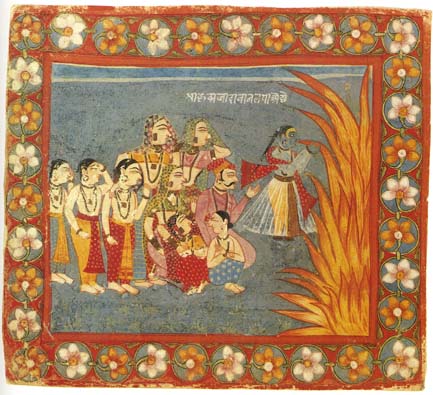
CHIPKO: A case study in CIVIL DISOBEDIENCE
and NON VIOLENT DIRECT ACTION
Ryan Redmond
Christa McAuliffe Regional Charter Public School, Framingham, MA
|
ACTIVITY TWO: A Foray into Miniature Painting I. Read the Author's Note and Illustrator's Notes on the last page of Aani and the Tree Huggers.
II. Discuss of the images in Aani of the Tree Huggers and their historical antecedents, with examples from the 1993 Los Angeles County Museum of Art exhibition book Pleasure Gardens of the Mind: Indian Painting From The Jane Greenough Green Collection by Pratapaditya Pal, et all.
While looking at the images from Pleasure Gardens, make sure to maintain emphasis on: the use of bright vibrant, primary colors; rich narrative style; the fact that they are not meant to be hung on walls, but stored and viewed up close, holding by hand; their miniature nature; the high detail; the worldly themes; and the religious themes (hero and heroine stories, god and goddess stories). (The elements outlined above come directly from Pal's introduction on pages 11-15.)
As Venantius Pinto, the illustrator of Aani and the Tree Huggers, tells us, the "illustrations were inspired by the 17th century styles of northern Indian miniature painting..." This activity, as such, could be approached on a series of levels. On the one hand, one could merely compare Pinto's images with the miniatures with an eye for form and composition. On the other hand, one could look more closely at the Hindu iconography and narrative. This would obviously require a thorough investigation of Hinduism itself, but as a result of such a project, the messages, metaphors, narratives and teachings could be brought forth for a richer understanding of the backdrop of Aani and the Tree Huggers. While I haven't included resources for such a study, I highly recommend this route.
That said, let's stick for the moment with what is outlined below. The format of the discussion, whether in small groups or a large group, whether preceeded by individual writing or group investigation, is completely up to the needs and wants of the particular class.
IMAGE 1
Rajasthan, Bikaner; c.1625
1. Look at (above) image on page 25 of Pleasure Gardens of the Mind. Follow with reading from page 24 and discussion of the text. Lastly, discussion on: Are there similarities between this image and the images from Aani? (If the book, and therefore the accompanying reading is not available, it should benoted that the painting tells the story of Vishnu rescuing the elephant called Gajendra ,"lord of the elephants." Retellings of the story, whose main message is that "Vishnu is always available to save a devotee who calls him at a time of distress," (Pal, et all, 24) can be found on the internet.)
IMAGE 2
Himachal Pradesh, Chamba; c. 1750
2. Look at (above) image on page 27. Follow with reading from page 26 and discussion of the text. Lastly, discussion on: Are there similarities between this image and the images from Aani? (If the book, and therefore the accompanying reading is not available, it should be noted that the painting tells the story of Krishna swallowing the fire. This image doesn't tell the more commonly known story of Krishna saving animals from a forest fire but tells the story of Krishna saving villagers from the inferno. The villagers of Vraja woke up one night to a raging fire around them. Seeking the help of Krishna, the people felt helpless. Because of their devotion, Krishna came to help them by swallowing up the fire.)
IMAGE 3
Himachal Pradesh, Bilaspur; c. 1775
3. Look at the image on page 35. Follow with reading from page 34 and discussion of the text. Lastly, discussion on: Are there similarities between this image and the images from Aani? (If the book, and therefore the accompanying reading is not available, it should be noted that the painting just presents a beautiful scene of villagers leading their animals out to the pasture. Krishna, in blue, is present.)
IMAGE 4
Rajasthan, Bundi; 1700-1725
4. Look at the image on page 58. Follow with reading from page 57 and discussion of the text. Lastly, discussion on: Are there similarities between this image and the images from Aani? (If the book, and therefore the accompanying reading is not available, it should be noted that the painting tells the story of the goddess Durga, on the back of the tiger, slaying a titan, in blue.)
|
This site was created by Ryan Redmond at the NEH Summer Institute "Cultures and Religions of the Himalayan Region," held at the College of the Holy Cross, Summer 2006



